OTTAWA, Ont. — The Trudeau Liberals will likely stick to talking points that paint a rosy picture of the Canadian economy ahead of the federal election, even as trade rifts between the U.S. and China trigger fears that the global economy could be headed for a slump.
An official representing Finance Minister Bill Morneau said a string of troubling economic data in recent days has not caused Ottawa to shift its fiscal outlook, citing a “stable and resilient financial sector” that has helped the Canadian economy grow at a rapid pace in recent years.
That position could set the groundwork for an election in which the economy is increasingly expected to feature prominently, with both the Conservatives and NDP looking to seize upon the rising cost of living and the toll it has taken on average families.
It would also serve as a stark contrast from the Liberals’ 2015 campaign, in which Prime Minister Justin Trudeau departed from other party leaders by promising to boost fiscal spending in a bid to correct the ailing economy. The promise involved billions in stimulus spending, including on infrastructure, funded in part by running budget deficits.
In a written statement, Finance spokesperson Pierre-Olivier Herbert said the ministry is “concerned to see trade tensions escalate between China and the United States and their potential impact on global growth,” but added the minister would continue to spend in what he called a “fiscally responsible way.”
Analysts are warning the global economy could be turning the corner and heading into negative territory after the Federal Reserve recently cut its interest rate for the first time since 2008, citing the ongoing trade spat between the U.S. and China, as well as a depressed manufacturing sector.
The move set off a spate of similar cuts: central bankers in India, New Zealand and Thailand surprised analysts with larger-than-expected interest rate reductions, signalling an increasingly cautionary outlook. Australia similarly reduced rates while the European Central Bank signalled it would trim its overnight rate in September.
Canada’s economy, meanwhile, nearly stalled over the past two quarters, falling well below one per cent growth after reaching as high as 3 per cent several years ago. Further clouding that outlook, the country shed 24,200 jobs in July, nudging the unemployment rate higher, while also seeing the strongest increase in wage growth since 2009.
Opposition parties were quick to criticize Trudeau amid an uncertain economic picture, saying stimulus spending over past years has left Canada in a bad position for a potential downturn.
“It will put an exclamation point on his recklessness,” said Conservative Finance critic Pierre Poilievre. “He told Canadians that we could just keep adding to the national credit card year after year without consequence.”
Poilievre said a Conservative government would cut spending and lower some taxes as a way to keep more money in the pockets of taxpayers, including eliminating the $35-billion Canada Infrastructure Bank established by Trudeau. He also said it would cancel Canada’s contribution to the Asia Infrastructure Bank.
The Conservative government is staking much of its campaign message around the cost of living and affordability for taxpayers, in hopes it will win over families who are struggling to make ends meet.
NDP Finance critic Peter Julian also criticized what he categorizes as “corporate welfare” in the form of subsidies for big companies. He said Liberal talking points have ignored the most pertinent issue: rising consumer debt levels, which have put pressure on young families and would-be home buyers.
“They may spin it that everything is fine, their plan is working, but there is no doubt that there has been a significant worsening for the average Canadian family — there’s just no doubt,” he said.
While the federal government’s debt levels are lower than other developed nations on average, personal debt levels have ballooned in Canada to among the highest in the world. Mortgages, credit card debts and other expenses have increased to the point that the average Canadian now has over $1.81 in debts for every $1 in disposable income, well above $1.09 in the U.S.
“I’ve seen this with the Liberals for the last four years where they’re patting each other on the back while the family debt crisis has worsened,” Julian said.
He said the NDP would cut certain government grants for corporations while introducing a so-called “wealth tax” on the richest Canadians, offer grants for college and university students and spending heavily on affordable housing — initiatives that critics say would be needlessly costly.
But even as global trade rifts worsen, observers in Canada have maintained a mostly neutral view of the economy overall. Most analysts expect the Bank of Canada to follow the lead of other central bankers and cut interest rates, but say it could be delayed until early 2020 or later.
Many also expect GDP growth to substantially improve in the second quarter, after Alberta Premier Jason Kenney said he would ease part of an oil production cut in the province, and amid slightly higher prices for Canadian crude oil, which will begin to show in high-level data. Such a bump would give the Liberal government a majorly positive data point just months before voters head to the polls.
“One thing that’s different from 2015 is we actually had the unemployment rate rising at that time because of the oil shock,” said Doug Porter, deputy chief economist at BMO. “There were a number of cases to be made for fiscal stimulus at that time — it’s not quite as clear-cut right now.”
Others said that despite lower jobs growth in July, wage growth has been steadily growing in recent years.
Josh Nye, senior economist at RBC, said Canada has added an average of 35,000 jobs per month over the last year, well above the longtime average of closer to 10,000 jobs.
“We’re probably due for a bit of payback when you see job growth growing at such a strong number,” Nye said.
Poilievre said he was unsurprised that the Liberal position remains unchanged.
“I don’t think they even look at economic data,” he said. “They don’t have to because their ideology tells them to do the same no matter what the data says: if the economy is strong, they borrow, if the economy is weak, they borrow.”
• Email: [email protected] | Twitter: jesse_snyder
Copyright Postmedia Network Inc., 2019









